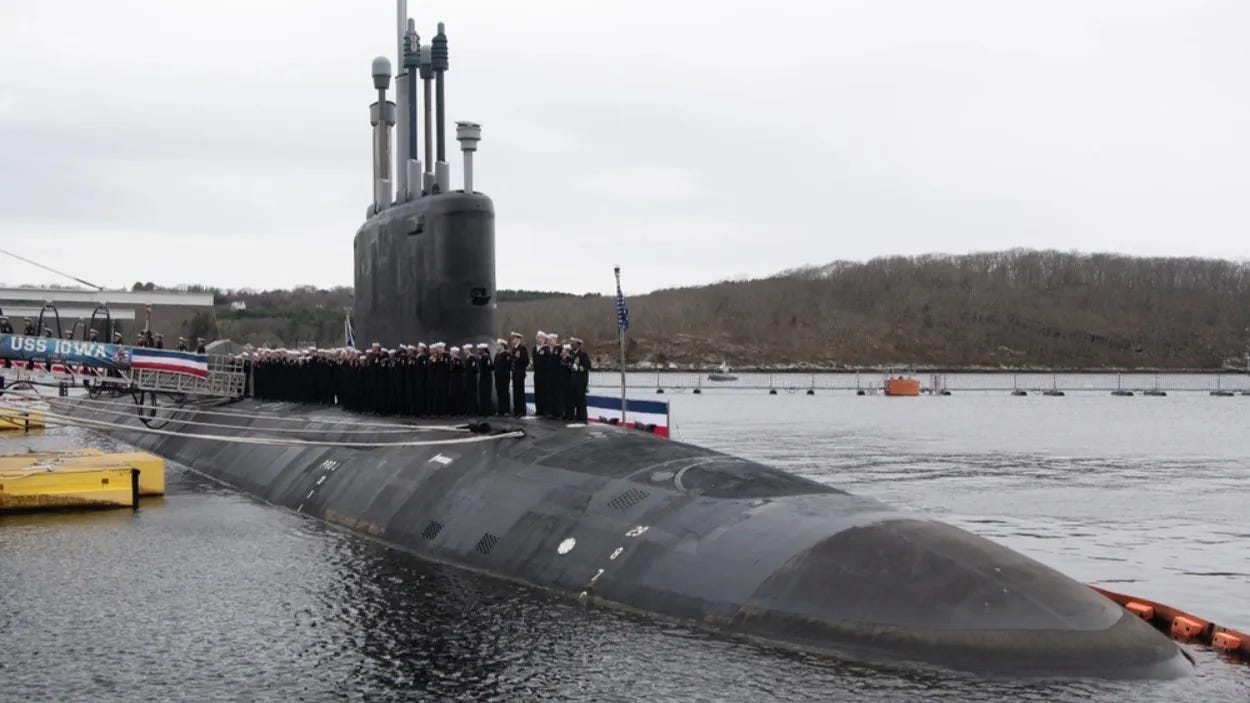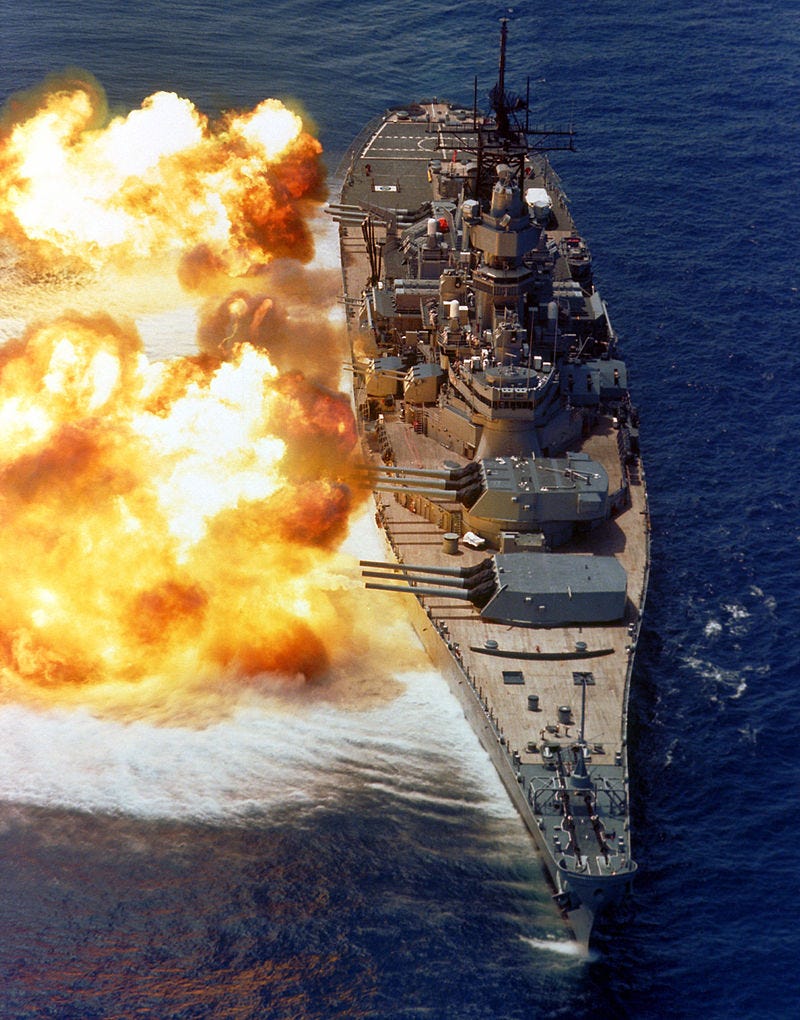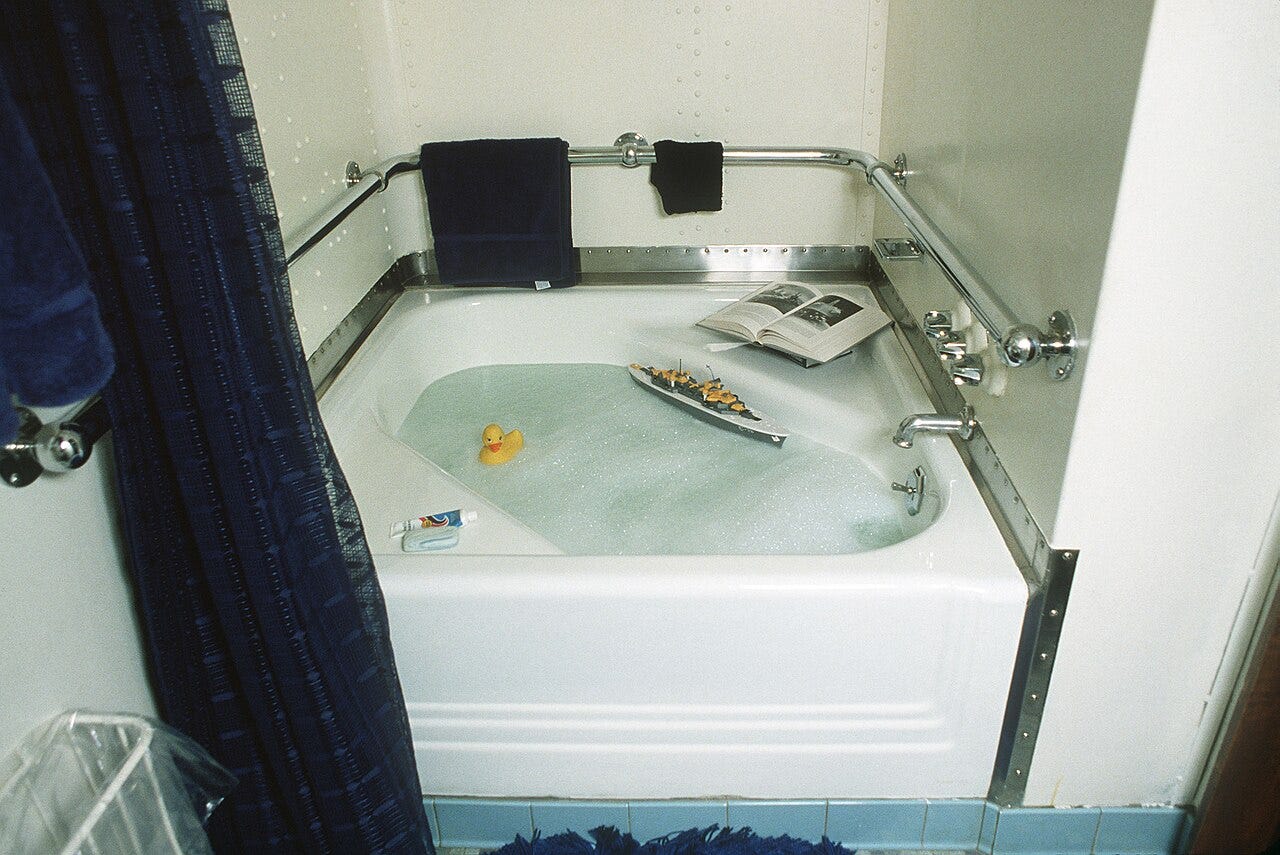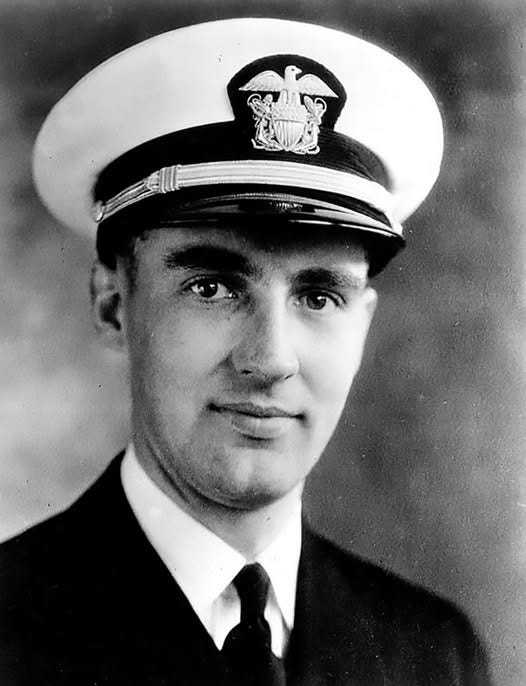The 3 USS Iowas and the long chain of Naval ships named for Iowa and Iowans
First of two newsletters dealing with the Naval ships named for Iowa, its people and places
The Navy launched a new USS Iowa this month, the third USS Iowa in an historic line of naval battleships that goes back to 1893.
It is a nuclear submarine, following in the wake of two battleships with the same name that played pivotal roles in four wars including World War I and II.
The new USS Iowa is the 24th submarine of its class, which first went into service in 2003. It took more than five years to build at a cost somewhere in the area of $2 billion. It is expected to remain in service until at least 2060.
It is described as a “fast-attack submarine” that can fire missiles as well as torpedoes. Officially, it is “designed to excel in anti-submarine warfare, strike warfare, special operations, intelligence, surveillance, and reconnaissance, irregular warfare, and mine warfare.”

OK, we get the message: Don’t mess with the USS Iowa.
Not that the earlier USS Iowas were ships to mess with.
Battleships were replaced slowly in the decades after World War II as scientific advancements beginning in the 1950s changed the world. Aircraft quickly became the preferred means for both defense and attack. The Navy turned its focus to new and bigger aircraft carriers, thus facilitating rapid air attacks from and to anywhere in the world, and to new high-tech submarines, which are superior for purposes of surveillance as well as stealth.
But during their day, battleships were the biggest, most threatening military vessels in existence.
The first battleships grew out of U.S. concerns in the 1880s that an era of large military ships thought to be on the horizon for foreign powers could make the American coastlines vulnerable to attack. The U.S. wanted a new class of faster, armored battleships with powerful, long-range guns to respond to any such threat.
Work began on this new class of battleships in the 1890s, and the Iowa was the fourth in this class to be built. Work began in 1893, and the ship was commissioned in 1897.
Just in time for the Spanish-American War.
However this mostly forgotten war may have started, it ended the substantial presence of Spain in the Western Hemisphere with the loss of Cuba and the Philippines plus smaller holdings. The USS Iowa came to battle with a crew of 36 officers and 540 enlisted men. Her presence was pivotal in the battle against the Spanish fleet, both at Guantanamo Bay and Santiago de Cuba.
The USS Iowa was an aging warship when World War I came along in 1917, but saw use as a receiving ship and training vessel along the Eastern seaboard, and then as a patrol and guard ship in that region.
She was decommissioned after the war in 1919 and eventually sunk in target practice in 1923.
The next USS Iowa was the lead ship in a new class of battleships designed in the 1930s as the world progressed inexorably to war. The U.S. wanted to be ready in the event that Germany might attempt to cross the Atlantic for an invasion of America.
The new first-in-its-class ship was ordered on July 1, 1939, exactly two months before the official beginning of World War II with Germany’s invasion of Poland. It was commissioned in February 1943, a little more than a year after the U.S. entered the war.
The ship was as long as a football field. Her nine largest guns, each 16 inches in diameter, were arranged in sets of three on each of three turrets. Each of these guns could fire exploding projectiles that weighed more than a ton and traveled a distance of 24 miles. Each turret required a crew of 77 to 94 men to operate.
She would become one of the most storied Naval vessels in history.

After patrolling along the eastern coastline of North America for a time, she crossed to the Pacific fleet. There, she participated in the campaign for the Marshall Islands and escorted U.S. aircraft carriers to various battle points.
The Iowa also famously played an important role in the war by transporting President Franklin D. Roosevelt to summit meetings with Churchill and Stalin in Cairo and Tehran. To meet Roosevelt’s needs, a bathtub was installed in the USS Iowa especially for him. Crippled by polio, Roosevelt could not have used the ship’s showers.

In the 1950s, the Iowa participated in the Korean War, firing at targets in North Korea. After a major rebuild in 1980, she continued in service for another 10 years until she was decommissioned in 1990. She was held in the mothball fleet for a time and then renovated as a museum ship. She remains on display today for tours at the Pacific Battleship Center at San Pedro, California.
Schedule your visit ahead of time. The tourist attraction is one of the most popular in Southern California.
From Iowa Places and People Came Names of Ships
Aside from the three USS Iowas, the Navy has named 26 other ships for Iowa people or places.
These include ships named for five Iowa cities – Davenport, Des Moines (2 ships), Dubuque (2), Keokuk (2), and Sioux City. Who makes these decisions? What happened to Cedar Rapids? And two for Keokuk? Perhaps not as surprising as it might appear. Keokuk was one of the fastest-growing cities in Iowa up to about 1870. It was still the eighth largest city in the state in 1890, when the first USS Keokuk was under construction. The first Keokuk was the first Naval ship to be named for Iowa or anything connected with the state.
Naval ships also have been named for 13 Iowa people – including two ships named for the five Sulllivan brothers from Waterloo, who famously went down with their ship in World War II, the worst military tragedy for any family in American history.
3 selected stories: The ships named for 3 Iowans who died for their country in WWII
Frederick T. Weber
He was born in Des Moines and graduated from Drake University in 1935. He enlisted in the Naval Reserve and was attached to a bombing squadron based at Pearl Harbor. He survived the December 7, 1941, attack on the American fleet because he and another airman were on scheduled air patrols of the harbor during the attack. The two planes became separated and Weber’s companion died as his plane was shot down.
A few months later, with Japanese ships advancing toward the critical Midway Island in the Pacific, Weber and his comrades took to the air to try to destroy Japanese ships before they reached Midway.
After 2 ½ hours in the air, the American airmen located three large Japanese carriers with numerous escorts headed toward Midway. Two of the three ships were taken out by Weber’s air group; one of them being seriously damaged by a bomb dropped by Weber’s plane, setting the ship up for destruction by another of the U.S. planes.
The U.S. planes then returned to their ship, but Weber soon left again with five other U.S. planes in pursuit of the remaining Japanese carrier. The carrier was destroyed, but not before Weber’s plane was shot down; he and his gunner died in the Pacific.
Ensign Weber was awarded the Navy Cross posthumously for his actions during the Air Battle of Midway. He made two dive-bombing attacks on Japanese aircraft carriers despite significant opposition. Flying “in the face of concentrated anti-aircraft fire and overwhelming fighter opposition,” he scored a direct hit on the first attack, and was shot down on the second.
The USS Weber, a destroyer escort, was commissioned on June 30, 1943, and served through the remainder of the war. It was decommissioned in 1947 and intentionally sunk in target practice in 1962.
Aloysius Schmitt
He was born in Dubuque and attended what is now Loras College there. He studied for the priesthood in Rome and then served as an associate pastor at St. Mary’s Church in Dubuque. He joined the U.S. Navy in 1939 and was serving as a chaplain on the USS Oklahoma based at Pearl Harbor on December 7, 1941. The ship was hit and capsized.
Father Schmitt was trapped with other men in a compartment with a small porthole providing the only possible escape. He worked to help a number of the men through the porthole to safety. When it came his turn to leave, he became stuck in a seam in the porthole. Knowing that other men waited behind him, he insisted in being pushed back into the compartment so that others could escape. He was one of 388 men who died with their sunken ship that day.
The bodies of those aboard the Oklahoma were recovered in 1943 and buried in Hawaii as unknown American seamen. In 2015, the remains were exhumed for possible DNA matching. Father Schmitt’s remains were matched with a relative and returned to Christ the King Chapel at Loras College for a memorial service and burial. He was the first religious leader to die in service of his country in World War II. The USS Schmitt, a destroyer escort named for him, went into service in 1943 and served until being decommissioned in 1949. It was sold to Taiwan in 1968.


Kenneth W. Durant
He was born in Algona, Iowa, in 1919, the only child of Solomon and Minnie Durant, who farmed near Algona. He graduated from Algona High School and enlisted in the Navy in June 1940, training as a medic (pharmacist’s mate third class). By 1942, he had moved over to the Marine Corps in the same position.
In mid-1942, the Japanese began building an airfield at Guadalcanal in the Solomon Islands of the Pacific Ocean. Although situated in the middle of nowhere in the South Pacific, hundreds of miles northeast of Australia, the U.S. deemed a Japanese airbase a threat to several U.S. airbases in the South Pacific.
Within a month, the U.S. sent 6,000 marines to Guadalcanal to try to take control of the base, occupied by 2,000 Japanese. The battle would last six months and would include some of the bloodiest confrontations of the war. By the time it ended, the Japanese had lost 24,000 men; the U.S. had lost 1,600; both sides had lost 24 warships each.
On November 3, 1942, Kenneth Durant was a medic with a Marine unit that was advancing toward where most of the Japanese troops sheltered, Marine platoon leader Paul Moore recalled later. Here is his story:
The Marines moved forward against the Japanese crawling a distance, then jumping up and running and hitting the deck behind a log or in some protected place. They had troops with automatic weapons providing fire cover as they approached the beach. With about 100 yards to go, the platoon hit an open area and started getting lacerated by Japanese machine gun fire.
Moore watched four or five of his men go down with two or three others wounded. Corpsmen raced from position to position trying to help the wounded.
Pharmacists’ Mate Durant “cut a notable figure as he worked forward with the lead platoons . . . treating wounds and bringing men off the line. Completely exhausted, he paused at the company command post for a rest.
“A Marine just 15 yards away was hit and cried out for a corpsman. Durant immediately got to his feet and ran to help . . . He was shot and killed before reaching his man.” Moore wrote later.
Durant and four other Marines from the same company were buried in shallow graves on the beach. Subsequent fighting destroyed all traces of the graves, and no remains were ever recovered.
Durant received a posthumous Silver Star for his “gallant actions and selfless devotion to duty.”
Coincidentally, the five Sullivan brothers of Waterloo also lost their lives at Guadalcanal when the ship on which they served, the USS Juneau, was sunk by the Japanese. It happened in the massive Battle of Guadalcanal, 10 days after Kenneth Durant was killed.
The USS Durant, a destroyer escort named for him, was launched in August 1943; the young Marine’s parents attended, and his mother christened the ship.
The Durant made eight voyages as a convoy escort to African ports in 1944 and ’45, guarding men and supplies essential for Allied troops in the European theater. In her last crossing with other escorts, a German submarine surrendered to them.
After the war, the Durant was loaned to the Coast Guard for several years. She was returned to the Navy in 1954 and served in various capacities until decommissioned in 1964. She was sold for scrap in 1974.
Tomorrow: More about Naval ships named for Iowa places; the unlikely connection between a New York industrial giant and a small rural county in Iowa.
Sources: Iowa’s Naval History, Naval History and Heritage Command, www.history.navy.mil; USS Iowa (BB-4), wikipedia.org; List of battleships of the United States Navy, wikipedia.org; Armament of the Iowa-class battleship, wikipedia.com; Battleship of Presidents - Battleship USS Iowa Museum, pacificbattleship.com; Battle of Guadfalcanal, Facts, Map & Significance, Britannica.com; Frederick T. Weber, wikipedia.org; Aloysius Schmitt, wikipedia.org; Kenneth William Durant, missingmarines.com; Kenneth William Durant, valor.militarytimes.com; Durant (DE-389), history.navy. mil/research; USS Durant, wikipedia.org.
NOTE TO READERS: I write this newsletter, Arnold Garson: Second Thoughts, as a member of the Iowa Writers’ Collaborative. You can subscribe for free. However, this newsletter requires substantial time for research. If you enjoy reading it, please consider showing your support by becoming a paid subscriber at the level that feels right for you. Click on the “Subscribe now” button here. Pricing begins at less than $2 per newsletter.
Iowa Writers Collaborative Roundup
Linking readers and professional writers who care about Iowa.





